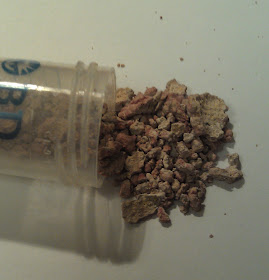A middle-aged male presented with recurrent urinary tract infections and cystoscopy revealed a large bladder stone (7.0 x 5.2 cm) filling the whole bladder.
The object was removed by open cystolithotomy and sent to the lab for bladder stone analysis. 8.7 grams of material was removed from the 'stone' and analyzed (see below, image courtesy of Dr. Tom Moyer). It was found to be composed of 10% uric acid and 90% ammonium urate.
More surprising was the object discovered in the center of the 'stone' (shown below), which was immediately sent to the parasitology lab.
Identification?





Wow, what a finding. From the circular cross section and the appearance of the rings or striation, this gives a hint that it may be an annellide, or more likely a nematode. The size length wise may point toward the common round worm or Ascaris lumbricoides. The location is very unusual, though Ascaris has been found to be a great wanderer. Well, that's my guess. Feel free to correct.
ReplyDeleteFlorida fan
I don't think it's Ascaris, you can see rings arround the body.
ReplyDeleteAscaris is smooth.
Don't know what it is though.
Hans Naus
I think it's a cast of the urinary collecting system, maybe from the ureter.
ReplyDeleteI think it's a calcified specimen of Hirudo medicinalis--ie the medicinal leech which migrated up the urethra to the urinary bladder. mpate
ReplyDeleteWhat a find indeed! The migration of an adult parasitic nematode to the urinary tract is an attractive explanation, but I'm not sure which one. Could it also be possible that this "litho-form" is the remnants of a worm deliberately introduced into the urethra and accidentally pushed into the bladder?
ReplyDeleteIt seems like a stretch (and it's kind of embarrassing to discuss), but case reports have been written about foreign objects (including telephone cables, copper wire, etc.) being intentionally inserted into the urethra and subsequently "lost" in the bladder.
If nothing else, this suggestion should give you and your viewers something to cringe (and possibly chuckle) about.
Can it be an earthworm ?
ReplyDeleteMicrobeMan,
ReplyDeleteabout case reports...
it could be "ok" for a woman, but a man, with average 20 cm urethra?!
definately not ascaris lumbricoides
seems to be annelida phylum
and for me the most "suitable" is Hirudinea
Looks likes a cast or UFO
ReplyDeleteFishing lure?
Dioctophyme renale - the giant kidney worm :)
ReplyDeleteThe only explanations I have are that it's either a cast or something that was introduced through the urethra.
ReplyDeleteI can't think of any human parasite of that size that might be found in the bladder.
Not a parasite, a foreign body.
ReplyDeleteI think this is from a published case this year? by Schmitt et al? They found it was a fake fishing worm I think...
Yes! published in the journal of clinical microbiology. Moyer is also an author. Though I dont have free access to the journal only the abstract and figures, so have no idea how they explained how it got here? :( has anyone got access to this paper?
http://www.ncbi.nlm.nih.gov/pubmed/22535991
and if so, can they send it to me?
luke.roberts11@imperial.ac.uk
:)
Nice job Lukus! I'll send you the paper tomorrow when I'm back in the office. If anyone else wants a copy, please give me your email address and I will send it along.
ReplyDeleteBobbi
Dr. Pritt -
ReplyDeleteI will take a copy of the paper. I believe that you already have my e-mail address. Thank you!
Ryan
please could you send me a copy of the article.
ReplyDeletehnaus@tergooiziekenhuizen.nl
thanks in advance :)
Dr. Pritt
ReplyDeleteFlorida fan would also love to have a copy. Thanks.
I was close with my idea of an earthworm :)
ReplyDeleteIn our laboratory we get eartworms regulary.
They have been found in the toilet and people think they came out with their feces.
Hans Naus